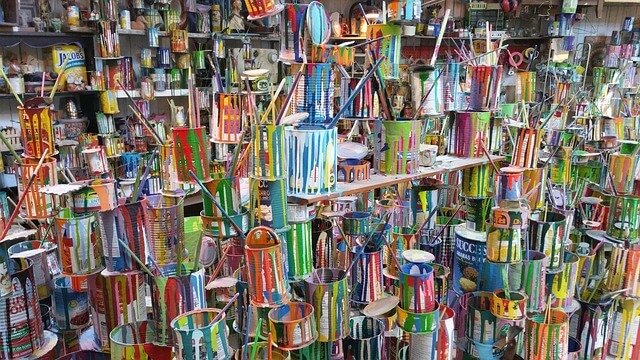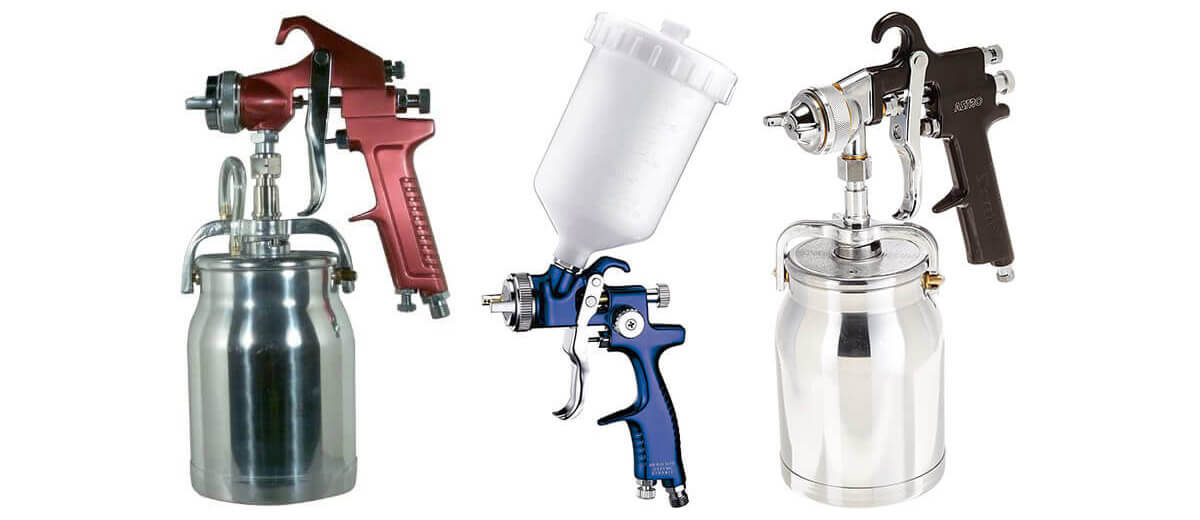What is LVLP paint sprayer?
LVLP stands for “Low Volume Low Pressure” and refers to a paint sprayer that uses a low volume of air at a low pressure to atomize and spray paint. LVLP sprayers are generally more efficient and produce less overspray than traditional high-pressure paint sprayers, but they may not be suitable for all types of paint or coating applications.
Table of Contents
- Is LVLP slower than HVLP sprayer?
- Why Choose LVLP Spray Guns?
- Is there any difference between HVLP and LVLP sprayer guns?
- Efficiency comparison of LVLP and HVLP Spray Guns
- What is LVLP Transfer Efficiency?
- Two types of LVLP Guns – bottom-fed and gravity-fed guns.
- LVLP gun pattern control knob
- LVLP system is environment friendly
- Difference between HVLP and LVLP
- Conclusion
- FAQ
Is LVLP slower than HVLP sprayer?
LVLP paint sprayers are generally slower than HVLP (High Volume Low Pressure) sprayers, as they use a lower volume of air and paint to achieve the same coverage. However, LVLP sprayers are often more efficient in paint usage and can produce a smoother finish with less overspray. The choice between LVLP and HVLP sprayers depends on the user’s specific project requirements and personal preferences.
Why Choose LVLP Spray Guns?
There are several reasons why someone might choose to use an LVLP spray gun for their painting or coating projects:
- Efficiency: LVLP sprayers use less paint and air than traditional high-pressure sprayers, making them more efficient and cost-effective.
- Environmental friendliness: Because LVLP sprayers use less paint and create less overspray, they are a more environmentally-friendly option.
- Better finish quality: LVLP sprayers are designed to produce a smooth and even finish with minimal overspray, resulting in a high-quality end result.
- Versatility: LVLP sprayers can be used for a variety of projects and coatings, including automotive painting, furniture refinishing, and general household painting.
- Ease of use: LVLP sprayers are typically easier to use than high-pressure sprayers, with fewer components and less complicated set-up and clean-up procedures.
Is there any difference between HVLP and LVLP sprayer guns?
Yes, there are several key differences between HVLP and LVLP sprayer systems:
- Air volume and pressure: HVLP sprayers use a high volume of air at a low air pressure, while LVLP sprayers use a low volume of air at low pressure. This difference affects the speed and efficiency of the sprayer, as well as the amount of overspray that is created.
- Atomization: HVLP sprayers typically use a larger spray nozzle and air cap, which results in a larger spray pattern and more complete atomization of the paint or coating. LVLP sprayers use a smaller nozzle and air cap, which can lead to less complete atomization and potentially a rougher finish.
- Paint transfer efficiency: LVLP sprayers are generally more efficient in paint transfer than HVLP sprayers, meaning that less paint is wasted and more of it ends up on the painted surface.
- Cost: HVLP sprayers tend to be more expensive than LVLP sprayers, as they require a more powerful compressor and other specialized components.
The choice between HVLP and LVLP sprayers depends on the specific needs and preferences of the user, as well as the nature of the painting or coating project.
You can not use latex paint with LVLP sprayers and only thinned latex with an HVLP sprayer.

Efficiency comparison of LVLP and HVLP Spray Guns
In terms of efficiency, LVLP spray guns are generally more efficient than HVLP spray guns for a few reasons:
- Paint usage: LVLP spray guns typically use less paint than HVLP spray guns because they produce less overspray and are designed to maximize the transfer of paint to the surface being painted.
- Air usage: LVLP spray guns also use less air than HVLP spray guns, which can help to reduce the overall energy consumption of the spraying process.
- Cost: Because LVLP spray guns use less paint and air, they can be a more cost-effective option in the long run.
That being said, HVLP spray guns are often preferred for certain types of projects where a finer finish is required, as they produce a finer mist of paint and are better suited to more detailed work. In some cases, HVLP spray guns may also be more efficient for large projects, where the additional speed and coverage provided by the high air volume can be beneficial.
What is LVLP Transfer Efficiency?
LVLP transfer efficiency is around 65% to 75%, and HVLP transfer efficiency is around 50% to 65%.
LVLP transfer efficiency refers to the amount of paint or coating transferred from the spray gun onto the surface being painted relative to the amount of paint lost to overspray or other waste.
LVLP spray guns are designed to maximize transfer efficiency, meaning that more paint or coating ends up on the painted surface, and less is wasted. This is accomplished through a combination of factors, including the low volume of air used by the spray gun, the design of the spray nozzle and air cap, and the viscosity of the paint or coating being sprayed.
In general, LVLP spray guns have a transfer efficiency of around 65% to 75%, meaning that roughly two-thirds to three-quarters of the paint or coating being sprayed ends up on the surface being painted. This is typically higher than the transfer efficiency of HVLP spray guns, which typically have a transfer efficiency of around 50% to 65%.
Higher transfer efficiency means less waste, lower cost, and a more even finish. However, it’s important to note that transfer efficiency can be influenced by a variety of factors, including the gun used, the type of paint or coating being sprayed, the air pressure and flow rate, and the skill and technique of the user.
Two types of LVLP Guns – bottom-fed and gravity-fed guns.

There are two main types of spray guns: bottom-fed and gravity-fed guns.
Bottom feed spray guns
These spray guns have a container, or cup, that sits below the gun and is attached to the gun body via a hose or tube. The paint or coating is drawn up from the cup and into the gun body using suction created by the low-pressure air stream. Bottom-fed guns are typically used for larger projects or for applications where a lot of paint or coating is required, as the larger cup size allows for more paint to be held at once.
Gravity feed spray guns
These spray guns have a container, or cup, that sits above the gun and is attached to the gun body via a hose or tube. The paint or coating is fed down into the gun body using gravity and drawn into the low-pressure air stream. Gravity-fed guns are typically used for smaller projects or applications where less paint or coating is required, as the smaller cup size is easier to handle and reduces the risk of spills or waste.
The choice between bottom-fed and gravity-fed guns will depend on the specific needs and requirements of the project, as well as the personal preference and experience of the user.
LVLP gun pattern control knob
The Pattern Control Knob on an LVLP spray gun is a feature that allows the user to adjust the width and shape of the spray pattern being delivered.
The knob is typically located near the front of the gun and can be turned to adjust the fan width of the spray pattern. This allows the user to control the size and shape of the spray pattern, which is particularly useful when working on different types of surfaces or when applying paint or coatings in hard-to-reach areas.
The Pattern Control Knob can be adjusted to create a narrow, concentrated spray pattern for precision work or a wider fan-shaped pattern for larger surface areas. It provides the user with greater control and flexibility when applying paint or coatings.
LVLP system is environment friendly
LVLP spray systems are generally considered to be more environmentally friendly than other types of spray systems, such as conventional or HVLP systems, for a few reasons:
- Reduced overspray: LVLP systems use a low volume of air at a low pressure, which helps reduce the amount of overspray created during the spraying process. This means that more of the paint or coating ends up on the surface being painted, and less is wasted, which can help reduce the pollution and environmental impact associated with these products.
- Lower emissions: Because LVLP systems use less air and less paint, they can help reduce the amount of volatile organic compounds (VOCs) released into the air during the spraying process. VOCs can be harmful to the environment and contribute to air pollution, so reducing their use can positively impact the environment.
- Energy efficiency: LVLP systems require less compressed air than other spray systems, which can help reduce energy consumption and lower greenhouse gas emissions associated with the production and use of energy.
Overall, LVLP spray systems can be a more environmentally-friendly option for a wide range of painting and coating projects. However, it’s important to note that the environmental impact of any spray system will depend on factors such as the type of paint or coating being used, the skill and technique of the user, and the specific conditions under which the product is being applied.
Difference between HVLP and LVLP
HVLP and LVLP are two types of spray guns that are commonly used in painting and finishing applications. The main difference between these two types of guns is the amount of air pressure they use to atomize the paint or coating being sprayed.
HVLP stands for “high volume, low pressure”. HVLP guns use a large volume of air at low pressure to atomize the paint or coating, resulting in a fine mist that can be applied to the surface being painted. This process reduces overspray and paint waste, and also reduces the amount of harmful emissions that are released into the environment. HVLP spray guns are commonly used for automotive painting, furniture finishing, and other applications that require a high-quality finish with minimal waste.
LVLP stands for “low volume, low pressure”. LVLP guns use a lower volume of air at a lower pressure to atomize the paint or coating, resulting in a slower, more controlled spray pattern. This type of gun is often used for touch-up work or other applications that require more precise control over the spray pattern.
LVLP paint sprayer can spray paints like Clearcoats, Thin Stains, Lacquers, Varnish, etc. HVLP can spray all types of paints that an LVLP can, including thinned latex.
The main advantages of HVLP spray guns over LVLP guns are that they are more efficient and produce less overspray, resulting in less waste and a more environmentally-friendly process. However, LVLP spray guns may be preferred for certain applications where more precise control is required.
Overall, the choice between an HVLP and LVLP spray gun will depend on the specific application and the user’s preferences and experience with each type of equipment.
To summarizes the main differences between HVLP and LVLP spray guns:
| HVLP Spray Guns | LVLP Spray Guns | |
|---|---|---|
| Air Pressure | High volume, low pressure 7-14 psi | Low volume, low pressure 4-10 psi |
| Atomization | Fine atomize paint | Fine atomize paint |
| Spray Pattern | Fine mist | Slower, more controlled spray pattern |
| Efficiency | More efficient, less overspray | Less efficient, more overspray |
| Waste Reduction | Reduces paint waste | Increases paint waste |
| Environmental Impact | Produces fewer emissions | Produces more emissions |
| Applications | Automotive painting, furniture finishing, and other applications requiring high-quality finish | Touch-up work, applications requiring more precise control |
Note: This table is intended to provide a general comparison between HVLP and LVLP spray guns, and individual models and manufacturers may have different specifications and features.
Conclusion
LVLP (Low Volume Low Pressure) spray guns are an efficient and cost-effective way to apply paint and coatings to a variety of surfaces. They use low pressure and low volume to create a fine, controlled spray pattern that reduces overspray, bounce back, and paint waste.
LVLP guns come in different types, including bottom-fed and gravity-fed guns, and are ideal for a wide range of painting and coating projects. When used and maintained properly, LVLP spray guns can provide a high-quality finish while also reducing emissions, energy costs, and environmental impact.
FAQ
Question:
What are the advantages of using an LVLP spray gun?
Answer:
Some advantages of using an LVLP spray gun include reduced overspray, lower paint waste, reduced emissions, and lower energy costs. LVLP guns also tend to be more user-friendly and easier to control than other types of spray guns.
Question:
How does an LVLP spray gun work?
Answer:
An LVLP spray gun uses low volume and low pressure to create a fine mist of paint or coating that is directed at the surface being painted. The low pressure helps to reduce overspray and bounce back, while the low volume helps to reduce paint waste.
Question:
What types of projects are best suited for LVLP spray guns?
Answer:
LVLP spray guns are ideal for a wide range of painting and coating projects, including automotive painting, furniture refinishing, and interior painting. They are particularly well-suited for projects that require a fine, controlled spray pattern and where overspray and paint waste must be kept to a minimum.
Question:
Can an LVLP spray gun be used with different types of paint and coatings?
Answer:
Yes, LVLP spray guns can be used with a variety of paints and coatings, including oil-based and water-based paints, lacquers, stains, and sealers. However, it is important to select the appropriate spray gun and tip size for the specific type of paint or coating being used and follow the manufacturer’s instructions for use and maintenance.
Question:
What is the difference between a bottom-fed and gravity-fed LVLP spray gun?
Answer:
Bottom-fed LVLP spray guns have a container or cup that sits below the gun and is attached to the gun body via a hose or tube. Gravity-fed LVLP spray guns have a container or cup that sits above the gun and is attached to the gun body via a hose or tube. The choice between bottom-fed and gravity-fed LVLP spray guns will depend on the specific needs and requirements of the project.
Question:
How do I clean and maintain my LVLP spray gun?
Answer:
To keep your LVLP spray gun in good working order, it is important to clean it thoroughly after each use and to follow the manufacturer’s instructions for maintenance. This may include disassembling the gun, cleaning the individual components with a solvent or cleaner, and storing the gun in a dry, cool place when not in use. It is also important to replace any worn or damaged parts as needed to ensure optimal performance.


